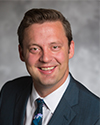For Emory Orthopedic Surgeon Eric Wagner, MD, research isn’t just a side pursuit. Despite maintaining a busy clinical practice, Wagner has managed to make research into what he calls a “second career.” Wagner and his partner, Michael Gottschalk, MD, currently have over 45 ongoing projects, with topics running the gambit from managing opioid addiction to helping tendons heal. Wagner has published over 185 articles in peer-reviewed journals, and his work has had a substantial impact in improving patient outcomes from orthopedic procedures.
“We take some complex surgeries where patients don’t traditionally do as well and try to make them better by looking at them from a surgical standpoint, basic science standpoint, and from a patient prospective, as in how do they do afterward and how can we better control their pain,” Wagner said.
Wagner first became interested in his field of research during his time in medical school at the University of Chicago. He went on to further develop expertise with a residency at Mayo Clinic and a research fellowship at Harvard. Today, he focuses on hand, shoulder, and upper extremity repair as an orthopedic surgeon at Emory. Wagner says he’s fortunate to have the support of his department in conducting research while also focusing on his medical practice. He is also assisted by research assistants, medical students, and residents.
Wagner’s research directly compliments his work as a surgeon, as he seeks to find innovative ways of helping patients recover post-surgery. One area Wagner has examined is using stem cells to augment the healing process improve recovery times for tissue connecting tendons and bones post-surgery. Wagner has also examined new techniques such as tendon transfers to replace paralyzed muscles and torn rotator cuffs and novel implants for the shoulder and wrist. A third project Wagner is currently working on is analyzing the opioid epidemic, with the goal of moving toward opioid free surgeries.
“One of my favorite things is looking at novel or relatively novel ways of doing complex things, like healing injuries that can’t be repaired using traditional methods,” Wagner said. “And so, looking at some of the different techniques and different implants, or traditional pathologies/techniques in ways others have not and ways to make those better, I think is interesting and it has some cool potential applications down the road.”
Wagner is looking at commercializing several of his innovations, including developments in wrist arthroplasty, tendon repair, elbow arthroplasty, and the wearable devices. He says that the biggest motivation for him to commercialize these innovations is not the money associated with commercialization but rather the opportunity to fund further research in his lab. With durations of grants for projects sometimes uncertain, commercialization can provide a more stable funding source. It can also however be a costly and time-consuming route to pursue.
“Commercialization is without question challenging,” Wagner said. “It’s been hard to find the balance to put in the time needed to take the next step beyond the concept ideas and actually commercialize them.”
One resource that has been helpful for Wagner as he navigates the process for commercialization while protecting intellectual property is Emory’s Office of Technology (OTT) Transfer. Wagner has met with the OTT several times to explore avenues for the licensing and commercialization of his innovations.
“We’ve been meeting with OTT, and they’ve been putting me and my partners in contact with various people that can help us take these projects to the next step,” Wagner said. “At some point, I hope we can form an actual, real partnership with them on some of these ideas.”
For those hoping to follow his career path, Wagner believes that focus is an important trait to possess. This means choosing projects that are manageable and paying attention to the steps needed for them to turn from ideas to reality, such as grant proposals. It also means not losing sight of the ultimate goal, whether that’s publication, commercialization, or something else. As Wagner says, it’s a lot easier to keep the momentum of a project going than trying to pick it back up after it’s been halted.
“Maintaining momentum on projects is something I’ve improved, along with my colleagues,” Wagner said. “And I wish from the beginning I had been a little bit more diligent on keeping the momentum on some of the bigger things that we have going on.”
